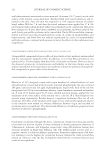EFFECT OF A UREA-BASED COMPOUNDED MOISTURIZER 203 (i) Samin ® emolient cream (urea 5%) Golafshan Co, Tehran, Iran, containing hydrophilic petrolatum (white petrolatum, white wax, stearyl alcohol, and cholesterol), 5% urea, polyacrylamide C13-14 isoparaffi n Laureth-7, phenoxyethanol, benzoic acid esters, and deionized water. (ii) Samin ® emolient cream (urea 10%) Golafshan Co, containing hydrophilic petrolatum (white petrolatum, white wax, stearyl alcohol, and cholesterol), 10% urea, polyacrylamide C13-14 isoparaffi n Laureth-7, phenoxyethanol, benzoic acid esters, and deionized water. (iii) S i milar compounded formulations prepared by an expert pharmacist with compound- ing cream containing hydrophilic petrolatum, urea 5%, and deionized water. (iv) Com p ounding cream containing hydrophilic petrolatum, urea 10%, and deionized water. A simple hydrophilic cream (cream-based preparation) was used as the control formulation, containing cetyl alcohol, stearic acid, propylene glycol, and propyleparaben. The detailed ingredients of the products are shown in Table I. To prepa re the compounding products, urea crystals were triturated to fi ne powder using mortar and pestle, and then water was added to dissolve urea. Finally, the solution was incorporated into the hydrophilic petrolatum very gradually using a spatula until the smooth and uniform product was obtained. It was performed in room temperature. Condition of preparation was like a pharmacy in which there were no industrial instru- ments available. The fi nal product was compared with the commercial one by organolep- tic properties (color, odor, and texture), and it was similar. STUDY PR OTOCOL Subjects underwent a conditioning period of 3 d before the study. No application of topical products to the forearms was allowed during this period to ensure there were no residual effects from any product application. Participants were also instructed not to wash the forearms within 3 h of arrival at the test facility. In the fi rst cohort, upper parts of the right and left forearms were randomly assigned for twice-a-day application of commercial and compounded products containing 5% urea in hydrophilic petrolatum. The same procedure was conducted for commercial and com- pounded products containing 10% urea in the second cohort of participants. In both cohorts, the right lower forearm was assigned for application of a cream-based formulation and the left lower one served as the control site and application of no topical product. The stud y was conducted from March to May 2020. Participants were supposed to use one fi nger tip of each cream, on a 5-cm × 5-cm area which was assigned for each product. RANDOMIZ ATION AND BLINDING We used a simple randomization sequence using a random number table. In each co hort, both compounding and industrial preparations as well as cream-based formulation were packaged in similar anonymous jars, distinguished with different codes.
Table I Moisturizing Products Used in This Study Test products Active ingredients Other ingredients Water content (%) pH Price (IRR) Industrial urea 5% cream Hydrophilic petrolatum (white petrolatum, white wax, stearyl alcohol, and cholesterol) and urea Polyacrylamide C13–14 isoparaffi n Laureth-7, phenoxy thanol, benzoic acid esters, and deionized water 61 7.97 362,000 Industrial urea 10% cream 8.04 Compounded urea 5% cream Hydrophilic petrolatum (white petrolatum, white wax, stearyl alcohol, and cholesterol) and urea Deionized water 18.5 9.11 200,000 Compounded urea 10% cream 9.15 Cream base Cetyl alcohol, stearic acid, propylene glycol, and propyleparaben 20 6.25 200,000 JOURNAL OF COSMETIC SCIENCE 204
Purchased for the exclusive use of nofirst nolast (unknown) From: SCC Media Library & Resource Center (library.scconline.org)

























































































































